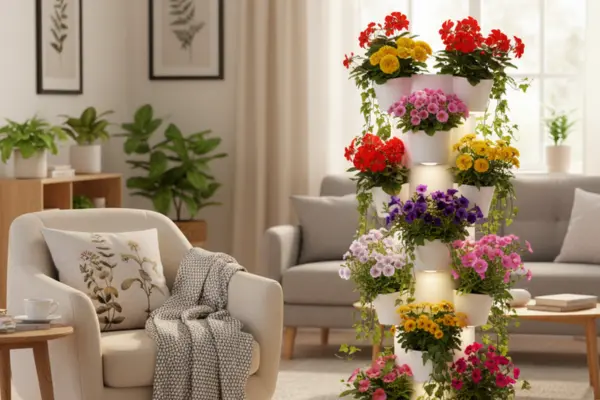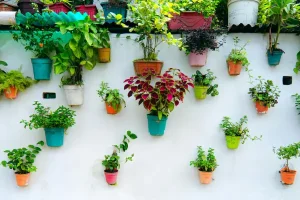Few sights are as cheerful as a vertical flower tower brimming with blooms. Whether it’s on a balcony, patio, or backyard, these towers provide a striking display of color. But many gardeners face a common frustration: flowers that fade too quickly.
The secret to a long-lasting, colorful tower lies in proper planning and care techniques that extend bloom time. In this guide, you’ll learn how to choose the right plants, care for them through the seasons, and keep your flower tower bursting with color for as long as possible.
Why Bloom Time Matters
Vertical towers pack many plants into a small footprint, so they can look spectacular—then fade quickly if flowers aren’t managed. Planning for longer bloom keeps your wall lively and colorful, and it also makes maintenance easier. When you choose varieties with staggered flowering periods and care for them well, you’ll enjoy steady color instead of short bursts that disappear.
Extended bloom time means:
- A more attractive garden for longer periods
- Better value from your plants and seeds
- Less frequent replanting and lower costs
- Seasonal interest from spring through fall (and even winter in mild climates)
- More pollinator activity, which helps fruiting plants nearby
How to get longer bloom on towers:
- Mix plant types: early, mid, and late bloomers; combine annuals (for nonstop color) with perennials (for reliable returns).
- Choose heat- and shade-tolerant varieties for your light conditions so flowers don’t stall in midsummer or fade in low-light corners.
- Deadhead weekly: remove spent blooms to trigger fresh flowers.
- Feed lightly and regularly; too much nitrogen grows leaves, not flowers.
- Keep even moisture—towers dry fast, especially on top tiers; adjust watering cycles during heat waves.
- Rotate or shuffle modules so each side gets its share of light.
With a little planning and routine care, your vertical garden will stay vibrant far beyond a single flush of color.
Step 1: Choose Long-Blooming Flowers
The foundation of a long-lasting tower is plant selection.
Best long-bloomers for vertical towers:
- Petunias: Continuous blooms from spring to frost with proper feeding.
- Geraniums: Strong summer flowers with minimal care.
- Begonias: Shade-tolerant with long-lasting color.
- Marigolds: Hardy annuals that flower steadily through summer.
- Impatiens: Excellent for shade towers, blooming until frost.
- Pansies & Violas: Cool-season flowers for early spring and late fall.
Step 2: Mix Seasonal Plants
No single flower blooms year-round. The trick is to layer your planting by season.
- Spring: Pansies, snapdragons, primroses.
- Summer: Petunias, marigolds, geraniums, zinnias.
- Fall: Chrysanthemums, violas, calendula.
- Winter (mild climates or indoors): Cyclamen, ornamental kale.
By rotating flowers, your tower will always have something in bloom.
Step 3: Deadhead and Prune Regularly
- Deadheading (removing spent blooms) encourages new flower production instead of seed formation.
- Pruning prevents plants from becoming leggy and helps maintain tower shape.
- For trailing plants like nasturtiums or ivy geraniums, trim back runners to avoid overshadowing other flowers.
Step 4: Feed and Water Consistently
- Fertilizing: Use a balanced liquid fertilizer every two weeks during bloom season.
- Watering: Towers dry out quickly—check daily in hot weather.
- Soil quality: Use a lightweight potting mix with added compost or slow-release fertilizer.
Step 5: Protect Against Stress
Environmental stress shortens bloom life.
- Heat: Provide partial shade during extreme summer heat.
- Cold: Cover towers with frost cloth in early spring and fall.
- Wind: Place towers in sheltered areas to protect delicate blooms.
Quick Reference Bloom Extension Table
| Technique | How It Helps |
| Long-blooming plants | Ensures extended color season |
| Seasonal layering | Continuous rotation of flowers |
| Deadheading | Stimulates new blooms |
| Regular feeding | Keeps flowers healthy & vibrant |
| Stress protection | Prevents premature flower drop |
Common Mistakes to Avoid
- Planting only one flower type – when it fades, the whole tower looks bare.
- Skipping fertilization – blooming drains nutrients quickly.
- Ignoring pruning – towers become overgrown and uneven.
- Not planning for seasonal shifts – flowers that thrive in June may fail in October.
FAQs
Q: How long can I expect flowers to last in a tower?
With good care, many annuals bloom from spring until the first frost. Using seasonal swaps extends display year-round.
Q: Do vertical flower towers need different soil than ground beds?
Yes. Towers dry out faster, so use lightweight, moisture-retentive potting mix.
Q: Can I grow perennials in a flower tower?
Yes. Hardy perennials like dianthus or lavender can provide repeat blooms each year, but annuals offer longer display seasons.
Q: Should I rotate the tower for even light?
If placed in partial sun, rotating every week helps flowers bloom evenly.
Next Steps & Related Reading
If pests are shortening your bloom cycle, read Preventing & Treating Common Flower Pests in Vertical Beds.
For design inspiration, see Designing a Color-Blocked Vertical Flower Garden to combine extended blooms with bold style.
Conclusion
Extending bloom time in a vertical flower tower is all about planning and consistent care. By choosing long-blooming plants, layering seasonal flowers, deadheading regularly, and protecting against stress, you can keep your tower full of color from early spring through late fall—and beyond in mild climates.
Which flowers would you plant first to create a tower that blooms for months—petunias for nonstop color, or pansies for cool-season cheer?




